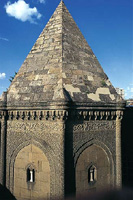Kayseri
 Ulu Mosque (Sultan Mosque-Center): It is in the city center, Cami Kebir District, just adjacent to Closed Bazaar. It is known as "Ulu Mosque" among natives, and referred as "Sultan Mosque" in former records. Ulu Mosque, is constructed between 1134 - 1143 by 3rd ruler of Danişmentliler, Melik Mehmet gazi, who made Kayseri his capital city. It is repaired during Seljukian Ruler, I. Gıyaseddin Keyhüsrev period on 1205 by Yağıbasanoğlu Muzaffereddin Mahmut.
Ulu Mosque (Sultan Mosque-Center): It is in the city center, Cami Kebir District, just adjacent to Closed Bazaar. It is known as "Ulu Mosque" among natives, and referred as "Sultan Mosque" in former records. Ulu Mosque, is constructed between 1134 - 1143 by 3rd ruler of Danişmentliler, Melik Mehmet gazi, who made Kayseri his capital city. It is repaired during Seljukian Ruler, I. Gıyaseddin Keyhüsrev period on 1205 by Yağıbasanoğlu Muzaffereddin Mahmut.
Güllük Mosque (Center): It is in the city, at south west of Düvenönü district, at Gülük Subdistrict. Danişmentliler belonging mosque and theology school composed this structure is constructed by Muzaffereddin Mahmut's daughter, "Atsız Elti Hatun", in 1211. Very beautiful tile mosaics adorned niche, is still standing as one of the pice of art of Seljukian tile art.
Lale Mosque (Center): It is in Lale District, and constructed by Lala Musluhiddin Paşa, and belongs to Seljukian period.
Ayetel Kürsi, which is written on seljukian style wooden niche is preserving its originality. Its minaret is constructed afterwrads, and there is a mausoleum at east and a hamam at north of this mosque.
Kurşunlu Mosque (Center): The mosque, which is constructed by Hacı Ahmet Paşa, is one of the pieces of art of Mimar Sinan, and has classical Ottoman architecture style, and constructed in 1585 according to its inscription. Marble masonry, niche, balcony and its pulpit is original.
Döner Kümbet (Center): This kumbert, which is constructed in memory of Princes Şah Cihan Hatun, is a piece of art, which draw attention with its uniquely characteristics. It is one of the most beautiful samples of Seljukian pieces of art in Kayseri. Various geometrical shapes, mythological creatures are carved as relieves on each side of polygonal shaped kumbet.
Kutluğ Hatun Mausoleum (Center): It is at east of Hunat Mosque. This kumbet, which is constructed with the order of Şah Kutluğ Hatun in 1349, is the master piece of its kind in Kayseri with big and adorned collonial structure.
Mahperi Hatun Mausoleum (Center): It is between Hunat Mosque and theology school, and a unique piece of art.
Sırçalı Kümbet (Center): Cylindrical shaped kumbet, is made up of cut stones with very smooth and master masonry.
Çifte Kümbet (Center): There are two kumbets on Sivas road and one kilometers away from Kayseri. One of these is demolished with no trace, and second one is well preserved and still standing today. It isconstructed in 1247 by herbrothers in memory of Melike Adile Hatun.
Soğanlı Valley Churches: Within the limits of the Soğanlı Valley Yeşilhisar district, it is 40 km from southeast of Ürgüp. Composed of two sections, the valley had continiously received immigrants starting from the Roman Period. The rock formations resembling to cones on the slopes of the valley were used as cemeteries by Romans while Byzantines made use of them as churches.
There are nearly 50 churches and caves in the region. They can be listed as follows; Karabaş, Gök, Tokalı, Karanlık, Yılanlı, Kubbeli, Balıklı, Geyikli and St. Barbara Churches.
Karabaş Church (Yeşilhisar): It is located on the right slope of the Soğanlı Valley. Besides Karabaş Church, the rocky places located there includes graves and constantly inhabited residences of the priest. Having been dyed in different times with several techniques, the church dated 11th century.
On the walls of the church there are the descriptions of Deesis, Herald ,Birth, Presenting Jesus to the Temple,Metamorphosis, Curicifixion, his ascend from the cross, his descend to heaven and some other descriptions of the saints.
Saint Barbara Church (Tahtalı Church): It is at the end of valley lying through west from Soğanlı Village. On its walls, appearance of the Prophet, Deesis, Herald, Visit, proof of the virginity, voyage via Beytüllahim, Birth, Jesus' descent to hell, seven sleepers and saint pictures are present.
Kubbeli Church: The church, whose domes are established with the adornment of Fairy Chimneys, shows an advanced architectural characteristic with its tonoz, abscissas.